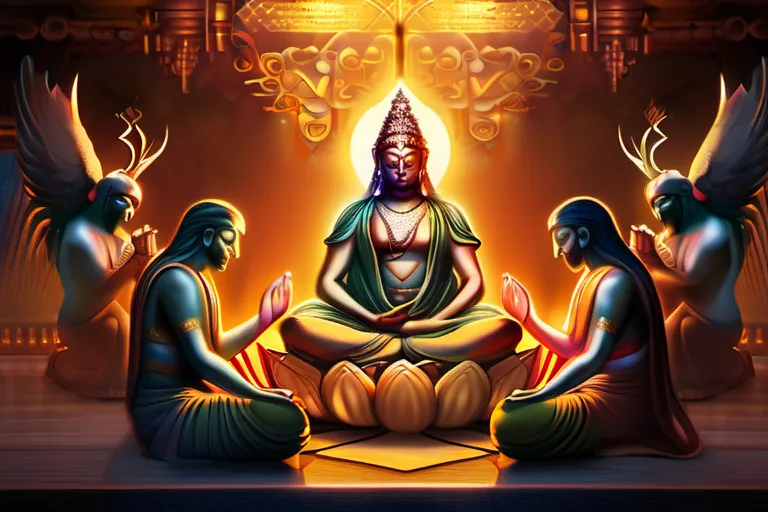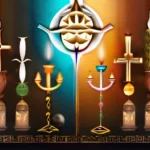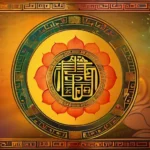Explore the origins, beliefs, and practices of polytheistic religions.
Polytheism is a religious belief system that involves worshipping multiple deities. In this article, we delve into the fascinating world of polytheism, tracing its roots, exploring various polytheistic religions, and examining their beliefs and practices.
The Origins of Polytheism
The origins of polytheism, like many profound human endeavors, trace back to the earliest moments when humans began to contemplate and interact with their world. Imagine standing on the edge of a lush, verdant valley, gazing up at towering mountains that seem almost to touch the sky. How did early humans perceive these awe-inspiring landscapes? Did they see them as mere natural wonders or as something more profound—living entities with their own spirits and desires?
Early civilizations often personified nature in their beliefs. Rivers were deities that controlled water flows, mountains were abodes of gods, and the sun was a life-giving entity revered by many cultures. Was it a leap in imagination to see the world as alive with spirits, or did these early perceptions arise from a deep-seated need for understanding?
The evolution of polytheism can be seen as a reflection of human societies themselves—dynamic and adaptable. As communities grew more complex, so too did their pantheons. Each new addition to the gods’ ranks often represented a different aspect of life or nature, from fertility and harvest to justice and war. These deities served not only as divine figures but also as metaphors for the human condition, embodying both fears and hopes.
Consider how the ancient Egyptians viewed their pantheon: each god had unique attributes yet were often interconnected in complex relationships. This web of divinity mirrored the intricate social structures within Egyptian society. Did these intricate beliefs serve to reinforce societal norms or perhaps offer a means for individual expression?
The journey from simple animistic spirits to elaborate polytheistic systems is as mysterious and profound as any human endeavor. It’s a testament to our innate desire to understand, control, and give meaning to the world around us. As we delve deeper into these ancient belief systems, we find not just a history of religion but also a rich tapestry of cultural development and human thought.
Key Polytheistic Religions
As we delve into key polytheistic religions, let’s journey through time and explore the rich tapestry of ancient beliefs that shaped civilizations. Imagine stepping back to the grand halls of Athena, the goddess of wisdom in Ancient Greece. She was not just a single deity but part of a vibrant pantheon, each god or goddess with distinct roles—Zeus as king of gods, Hermes as messenger, and Hestia as the hearth goddess. Their stories, filled with drama and intrigue, were woven into daily life, guiding people through their rituals and festivals.
In Rome, the transition from Troy to Rome brought with it a blend of Greek and Roman deities. The Romans adopted many Greek gods under new names but retained their complex family dynamics. Consider Jupiter, the king of gods, who mirrored Zeus in his thunderbolts and authority. His wife, Iuno, or Juno, played a crucial role as queen and protector. This blending of deities showed how polytheistic societies could coexist and adapt to new cultural influences.
Now, let’s travel north to the frosty lands of Scandinavia where Norse mythology thrived. Here, the gods were personified in nature, and their stories reflected the harsh realities of life. The Aesir gods, led by Odin, the all-father, and his son Thor, who wielded mighty hammer Mjolnir to battle giants, symbolized both wisdom and strength. These gods were not distant but closely tied to the lives of Norse people, their stories etched in runes on stones and tales passed down through generations.
In Egypt, the deities held a more hierarchical structure, with Re, the sun god, at the apex. The Egyptians believed in an afterlife where gods like Anubis, the jackal-headed god of embalming and the dead, played crucial roles. Their temples were not just places of worship but centers of power and knowledge, filled with rituals to appease the gods and ensure a smooth transition into the afterlife.
Each of these polytheistic religions offers a window into ancient cultures, revealing how people structured their lives around a complex web of divine beings. From Greece to Rome, Scandinavia to Egypt, these deities were not just abstract concepts but integral parts of daily life and societal fabric. By understanding the beliefs and practices of these major polytheistic religions, we gain insight into the human need for explanation, guidance, and connection with something greater than themselves.
Polytheism in Modern Times
How does polytheism stand tall in today’s world, where monotheistic beliefs dominate? Is it just a relic from ancient times, or has it found new life in contemporary societies? Polytheism isn’t merely about worshipping multiple gods; it’s deeply intertwined with the cultural identities of communities worldwide. How do these religions continue to shape and evolve within modern contexts?
Take Japan for example. Shinto, one of the oldest polytheistic traditions, remains vibrant amidst the bustling modernity of Tokyo. The shrine maidens, or kamigata, still perform rituals that date back centuries. These practices not only preserve ancient customs but also reinforce a sense of national and cultural identity in the face of globalization.
In African communities, traditional religions continue to thrive, despite efforts by colonial powers to suppress them. The Yoruba religion, for instance, with its pantheon of deities like Oya and Obatala, plays a crucial role in societal cohesion. These practices provide a framework for understanding the world and navigating life’s complexities.
Even in Europe, polytheism isn’t dead. Neo-pagan movements, such as Wicca, draw heavily from ancient traditions to form their belief systems. Practices like sabbats and esbats are common among adherents who seek a deeper connection with nature and spiritual forces. These groups often find solace and community in these traditional rituals.
The resilience of polytheism in modern times is a testament to its enduring relevance. It serves as a reminder that religion isn’t just about beliefs but also about cultural continuity and identity. As we explore the functions and attributes of deities in the following section, remember how these gods continue to shape our understanding of the world around us.
The Role of Deities in Polytheistic Religions
Imagine walking through a forest where every tree, rock, and stream holds its own spirit or deity. In polytheistic religions, each deity serves a unique role, much like how different characters in a story weave together to create an intricate narrative. These deities are not just passive observers; they actively influence the world around us, shaping our destinies and providing guidance through various aspects of life.
Consider Hermes, the swift-footed messenger god from Greek mythology. He embodies speed, cunning, and commerce. How do you think his attributes might have influenced trade routes or the development of communication systems in ancient societies? Similarly, Athena, the goddess of wisdom and strategy, would have been revered for her guidance during conflicts and in matters of statecraft. These deities are not just mythological figures but integral to understanding the cultural, social, and economic structures of polytheistic communities.
Moreover, the relationships between deities within a pantheon often mirror human interactions. Just as humans have families, friends, and enemies, so do the gods. For instance, in Roman mythology, Ceres, goddess of agriculture, has a complex relationship with her daughter, Diana, the huntress. This interplay between deities adds depth to their stories and reflects the nuanced nature of human relationships.
Understanding these roles and attributes helps us appreciate the multifaceted worldviews of polytheistic belief systems. Each deity is a lens through which one can view specific aspects of life, providing a comprehensive framework for understanding the universe and one’s place within it. By exploring the functions and attributes of deities in polytheism, we gain insights into how these ancient beliefs continue to shape modern cultural identities and practices.
Rituals and Practices in Polytheism
Rituals and practices in polytheistic religions are like the heartbeat of these ancient belief systems, pulsating through every ceremony and festivity. Imagine a grand orchestra where each deity plays their instrument – sometimes harmoniously, other times in dissonance, but always contributing to the symphony of life.
Offerings are central to many rituals, serving as a bridge between mortals and the divine realm. Think of them as tokens of gratitude or requests for blessings. For instance, ancient Greeks would offer honey, wine, and olive oil to their gods at temples, seeing these gifts as a means to appease or thank them for favor. In many ways, offerings are like letters to the deities – filled with reverence, humility, and hope.
Prayers too play a significant role in connecting believers to their pantheon. They are more than just words; they are acts of communication that resonate through time. Consider how in some polytheistic traditions, prayers can be as simple and personal as murmuring a prayer for guidance or protection during daily life, or as elaborate as community-wide rituals conducted by priests and priestesses.
Festivals, on the other hand, are grand celebrations marking significant events or cycles of nature. They serve not only as joyous occasions but also as opportunities to honor specific deities and reinforce communal bonds. Think of a festival like a colorful tapestry, woven with stories, songs, dances, and feasts that celebrate the gods’ roles in the world.
Each ritual and practice is unique, tailored to fit the cultural context and the specific needs of the community. These rituals are more than just traditions; they are living practices that reflect the dynamic nature of polytheism itself – ever-changing, yet profoundly rooted in tradition.
Polytheism vs. Monotheism: A Comparative Analysis
Imagine a world where the sky isn’t just one blue canvas but a tapestry woven with countless threads, each representing a different deity. In polytheism, this is exactly how many ancient cultures viewed their universe. Polytheism, as opposed to the more familiar monotheistic traditions, acknowledges and worships multiple gods or goddesses, each with distinct roles and attributes.
Let’s step back in time to explore these belief systems side by side. How does worshiping many deities compare to the singular focus of monotheism? In polytheism, life is a complex web, and every aspect—from weather patterns to personal fortune—has its own divine overseer. For example, Zeus, in Greek mythology, is not just about thunderstorms; he’s also the king of gods, a symbol of power and authority. Conversely, monotheism presents a simpler, more unified worldview where one God oversees all aspects of existence.
Consider this: if polytheism is like a bustling city with many neighborhoods, each with its own characteristics, what does monotheism represent? It’s akin to a single, vast metropolis where all the distinct flavors and cultures blend into one. In monotheism, there’s a sense of universal unity and harmony under one divine ruler.
The key difference lies in perspective: polytheists see the world as multifaceted, with each aspect requiring its own attention and respect. Monotheists view the world through a singular lens, where all is ultimately connected to their single God. Yet, both belief systems share a common goal—to understand and honor the divine, whether it’s one supreme being or many.
Both polytheism and monotheism are responses to the same fundamental human question: “Why is there something rather than nothing?” Each system offers its unique approach to this eternal inquiry. As we explore further into the intricacies of polytheistic rituals and practices, you might find yourself pondering which perspective resonates more with your own understanding of the world.
Conclusion
 By understanding the complexities and nuances of polytheism, we gain a deeper appreciation for the rich tapestry of human spirituality. This knowledge can foster greater cultural sensitivity and promote interfaith dialogue.
By understanding the complexities and nuances of polytheism, we gain a deeper appreciation for the rich tapestry of human spirituality. This knowledge can foster greater cultural sensitivity and promote interfaith dialogue.











